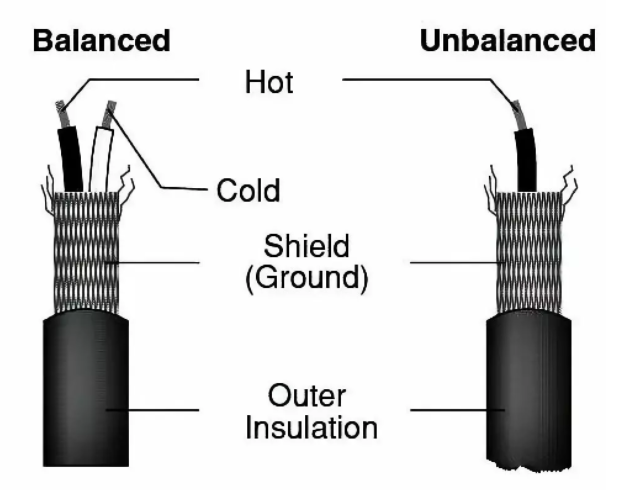What are balanced and unbalanced signals? How to see if your device is a balanced signal?
Views : 16735
Update time : 2022-05-31 17:50:46
The audio connector is the carrier of the audio signal, and the connectors are also different depending on the type of signal transmitted. Audio signals transmitted between audio devices can be roughly divided into two categories, balanced signals and unbalanced signals. After the sound wave is converted into an electrical signal, if it is transmitted directly, it is an unbalanced signal. If the original signal is inverted (the phase difference is 180 degrees), and then the inverted signal and the original signal are transmitted at the same time, it is called a balanced signal. Corresponding to it is the balanced transmission and unbalanced transmission of audio signals.
Balanced transmission is a widely used audio signal transmission method. It uses the principle of phase cancellation to minimize other interferences in the process of audio signal transmission, that is: the balanced signal is sent to the differential amplifier, the original signal and the anti-phase signal are subtracted, and the enhanced original signal is obtained. During transmission, the interference received by the two lines is almost the same. In the process of subtraction, the interference signal is subtracted, so the anti-interference ability is stronger. Therefore, balanced transmission generally appears on professional audio equipment, as well as occasions where the transmission distance is relatively long. This phenomenon of suppressing noise common to bipolar conductors in balanced signal lines is called common mode rejection. To achieve balanced transmission, three parallel wires are needed to achieve, namely the ground wire, the hot end wire, and the cold end wire. Therefore, the balanced input and output connectors must have three pins, such as XLR connectors and large three-core connectors.

What is the difference between a balanced signal line and an unbalanced signal line?
 Unbalanced signal lines are more likely to introduce noise and interference. If you cut an unbalanced signal wire, there are 2 wires inside: 1 conductor and 1 ground.
Unbalanced signal lines are more likely to introduce noise and interference. If you cut an unbalanced signal wire, there are 2 wires inside: 1 conductor and 1 ground.
 Balanced model line is just the opposite. It is designed to eliminate noise and interference. It does this by adding a conductor: 2 conductors and 1 ground wire. With the extra second conductor, the noise on both conductors is eliminated.
Balanced model line is just the opposite. It is designed to eliminate noise and interference. It does this by adding a conductor: 2 conductors and 1 ground wire. With the extra second conductor, the noise on both conductors is eliminated.
Does a balanced signal line guarantee a balanced connection (transmitting balanced signals)?
The answer is no! One thing to keep in mind here: if you want to maintain a balanced connection, you must have a balanced signal on the entire circuit. The summary is as follows:
 The output on your device
The output on your device
 Wire
Wire
 The input end of the cable (such as your mixer or microphone)
The input end of the cable (such as your mixer or microphone)
As long as one of the above is an unbalanced signal, then your connection is an unbalanced connection.
How can you be sure that your device is a balanced signal?
Your device is a balanced signal if it looks like this:
 It has XLR outputs or inputs
It has XLR outputs or inputs
 It is written on your device or in the manual
It is written on your device or in the manual
 It's a guitar or bass
It's a guitar or bass
 It is 3.5 mono or dual channel output
It is 3.5 mono or dual channel output
 It is RCA input or output
It is RCA input or output
Many devices with only 6.35 outputs are unbalanced. It's usually an unbalanced signal as well, if it doesn't have any guides.
Why is this knowledge so important?
Knowing the difference between balanced and unbalanced signal cables plays a key role in choosing the right cable. This will prevent signal loss and the introduction of noise when recording or performing. Using the wrong cable can even damage your device.
If you have a balanced signal device and a balanced signal mixer, then use balanced signal cables to ensure a good balanced signal connection.
But in case you can't use a balanced signal connection, keep the wires as short as possible.
Tips: If you want to use an unbalanced connection, please ensure that your unbalanced signal line is less than 1.8 meters, which can reduce signal interference well.
If you use a balanced connection, you can rest assured that you can use cables longer than 1.8 meters without worrying about signal interference. The most common balanced connection is to use an XLR cable.The XLR cable is the balanced signal line. They snap (with a snap) into the socket - so you don't inadvertently pull them out (which saves a lot of frenetic gig scenes). XLR cables can be very long without noise and signal interference.
XLR cables are generally used to connect the following equipment:
 microphone
microphone
 High-power speakers
High-power speakers
 Sound reinforcement system
Sound reinforcement system
 Instruments with XLR connectors
Instruments with XLR connectors
When you want to buy a high-quality Canon cable, you should also pay attention to the following points: 1. Look for the brand Cannon connector, and recommend the Neutrik Cannon connector. 2. The wire core is particularly important, and silver-plated copper or single crystal copper wire is recommended.
Contact Us:
 sales2@sinbosen.com
sales2@sinbosen.com
Whatsapp:https://api.whatsapp.com/send?l=en&phone=8616676738225

Balanced transmission is a widely used audio signal transmission method. It uses the principle of phase cancellation to minimize other interferences in the process of audio signal transmission, that is: the balanced signal is sent to the differential amplifier, the original signal and the anti-phase signal are subtracted, and the enhanced original signal is obtained. During transmission, the interference received by the two lines is almost the same. In the process of subtraction, the interference signal is subtracted, so the anti-interference ability is stronger. Therefore, balanced transmission generally appears on professional audio equipment, as well as occasions where the transmission distance is relatively long. This phenomenon of suppressing noise common to bipolar conductors in balanced signal lines is called common mode rejection. To achieve balanced transmission, three parallel wires are needed to achieve, namely the ground wire, the hot end wire, and the cold end wire. Therefore, the balanced input and output connectors must have three pins, such as XLR connectors and large three-core connectors.

What is the difference between a balanced signal line and an unbalanced signal line?
Does a balanced signal line guarantee a balanced connection (transmitting balanced signals)?
The answer is no! One thing to keep in mind here: if you want to maintain a balanced connection, you must have a balanced signal on the entire circuit. The summary is as follows:
As long as one of the above is an unbalanced signal, then your connection is an unbalanced connection.
How can you be sure that your device is a balanced signal?
Your device is a balanced signal if it looks like this:
Many devices with only 6.35 outputs are unbalanced. It's usually an unbalanced signal as well, if it doesn't have any guides.
Why is this knowledge so important?
Knowing the difference between balanced and unbalanced signal cables plays a key role in choosing the right cable. This will prevent signal loss and the introduction of noise when recording or performing. Using the wrong cable can even damage your device.
If you have a balanced signal device and a balanced signal mixer, then use balanced signal cables to ensure a good balanced signal connection.
But in case you can't use a balanced signal connection, keep the wires as short as possible.
Tips: If you want to use an unbalanced connection, please ensure that your unbalanced signal line is less than 1.8 meters, which can reduce signal interference well.
If you use a balanced connection, you can rest assured that you can use cables longer than 1.8 meters without worrying about signal interference. The most common balanced connection is to use an XLR cable.The XLR cable is the balanced signal line. They snap (with a snap) into the socket - so you don't inadvertently pull them out (which saves a lot of frenetic gig scenes). XLR cables can be very long without noise and signal interference.
XLR cables are generally used to connect the following equipment:
When you want to buy a high-quality Canon cable, you should also pay attention to the following points: 1. Look for the brand Cannon connector, and recommend the Neutrik Cannon connector. 2. The wire core is particularly important, and silver-plated copper or single crystal copper wire is recommended.
Contact Us:
Whatsapp:https://api.whatsapp.com/send?l=en&phone=8616676738225











